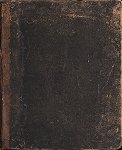AMPHISBOENA VERMICULARIS
AMPH.Tate species moves either backwards or forwards, as occasion may require, and is quite frequent in the woods of Brazil. Its body is cylindrical, from two feet to two and a half long, terminated by a very obtuse tail. It has no scales properly speaking, but its skin is divided into quadrilateral compartments disposed in rings round the body; 228 on the trunk and 26 on the tail. The lower lip is divided into six long and narrow plates; the head is small, rather sharp, protected by scutellae, and not distinguished from the neck. It has small eyes; the jaw is not dilatable, the teeth are conical, bent, unequal and distinct from each other; the nostrils are on the sides, and pierced in a single naso-rostral plate. The amphisboena is of a brownish color above, and a pinkish-white under the belly. The poison was taken from the living animal by cutting off part of its jaw, which was triturated immediately.
1. Debility. Sadness and lassitude in the morning, which leaves one while walking. Tender sadness which disposes one to be gentle and meek. Violent pain in the whole of the vertebral column, worse when walking, moving the arms or stooping.
5. Painful and large pimple on the left side of the upper lip, suppurating. Acne rosacea miliaria (a dry itch cured), covering extensive ellyptical spots; after the eruption healed, a furfuraceous desquamation took place wherever a pimple had been situated. Wakes at midnight, for ten consecutive nights. Disturbed sleep.
Fifteenth day. Depression.
10. Ennui. Impatience. Weight in the forehead and parietal regions. Weight at the forehead. Vertigo as if one would fall towards one side and is then impelled towards the opposite side by a contrary oscillation.
15. Pain at the inner canthus of the right eye as if a stye would form. Repeated beating at the right side of the forehead as if hail-stones fell upon it. Sweat about the head. Horrible headache, with sensation as if the feet were in the brain. Dizziness when turning round.
20. Constant twitching at the upper eyelids, especially the left. Constriction of the right eye as if strung together with a cord. Shooting pain in the outer angle of the left eye. Sensation as of a grain of sand in the right eye. Weariness of the eyes, in the evening, with pain and pricking when looking at the light.
25. Lachrymation and constriction of the left eye. Pain in the meatus auditorius, as if air were rushing in. Pricklings and beat at the right malar eminence. Dull pain is the right lower jawbone. Lancination and pain all through the right side of the head.
30. Pains in the right lower jaw, and considerable swelling aggravated by air and dampness. Swelling of the right lower jaw, worse in the open air. The teeth feel elongated and set on edge, especially the right lower molares. The toothache is worse in the evening and afternoon. Chewing is painful, but the contact of liquids is not painful.
35. Swelling of the tonsils. Deglutition is difficult, one is not able to swallow saliva. Protrusion of umbilical hernia. Chilliness and pains at the epigastrium. Tearing pain at the navel, all day.
40. Suppuration of inguinal hernia. The hernia is painful, and air is felt in it. Lancination in the navel as from a stiletto. Constipation. The miliary acne rosacea spreads over the chest, neck and back, with itching which is worse in the morning and decreases in the evening.
45. Gradually a white vesicle forms on every pimple, discharging a clear serum, after which the eruption dries up on the fifth day. Breaking out of little pimples, especially on the fore-arm. Painful swelling of the arm, on the fifteenth day. Cramp in the left leg. Painless drawing up of the legs.
50. Cramp in the left leg; it remains behind in walking as if paralyzed.
 Free Materia Medica books
Free Materia Medica books
